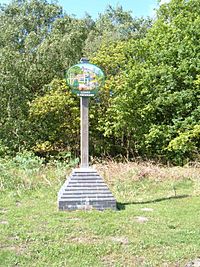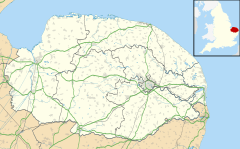Leziate facts for kids
Quick facts for kids Leziate |
|
|---|---|
 The Village sign, Leziate, Norfolk |
|
| Area | 11.37 km2 (4.39 sq mi) |
| Population | 592 (2011 census) |
| • Density | 52/km2 (130/sq mi) |
| OS grid reference | TF6719 |
| • London | 106 miles (171 km) |
| Civil parish |
|
| District | |
| Shire county | |
| Region | |
| Country | England |
| Sovereign state | United Kingdom |
| Post town | KING'S LYNN |
| Postcode district | PE32 |
| Dialling code | 01553 |
| Police | Norfolk |
| Fire | Norfolk |
| Ambulance | East of England |
| EU Parliament | East of England |
| UK Parliament |
|
Leziate is a small village in the county of Norfolk, England. It is also a civil parish, which is a local area with its own council. Leziate is about 44 miles (71 km) west of Norwich and 5.7 miles (9.2 km) east of King's Lynn. London is about 106 miles (171 km) to the south-south-west.
The village is located just south of the B1145, a road that connects King's Lynn and Mundesley. If you want to travel by train, the closest station is at King's Lynn. This station is on the Fen Line, which goes to Cambridge. The nearest airport for flights is Norwich International Airport. In 2011, the population of Leziate parish, which includes the nearby area of Ashwicken, was 592 people.
Contents
History of Leziate
Leziate is a large parish located in the western part of Norfolk. It sits east of the town of King's Lynn. The parish shares its borders with Grimston to the north, East Winch to the south, Bawsey to the west, and Gayton to the east.
There are two small settlements, or hamlets, within the Leziate parish: Leziate itself and Ashwicken. Both of these places are known as "shrunken villages." This means they were once much bigger. In the Middle Ages, Leziate village was larger. However, by the late 1400s, it had become so small that its parish was joined with Ashwicken. The name Leziate comes from an old English word meaning "meadow gate." Ashwicken also comes from old English and means "place at the dwellings" or "place at the ash trees."
Leziate in the Domesday Book
In 1086, a very important book called the Domesday Book was created. It was a survey of England ordered by William the Conqueror. When this book was put together, Leziate was part of the hundred of Freebridge. A "hundred" was an old way of dividing land in England. Leziate was quite small back then, with only three households. It had about 4 acres (1.6 ha) of meadow land and a mill.
Old Churches and Changes
Leziate once had its own church called All Saints. It was located east of Leziate Drove. Records from 1368 also mention a chapel dedicated to St Thomas. After Leziate parish joined with Ashwicken in the late 1400s, a powerful local lord named Thomas Thursby was accused of taking most of the common land for himself. He did this by enclosing it, which meant fencing it off. He also forced tenants out of their homes and then tore down their houses.
In 1602, the local priest, Mr. Bramwell, took the lead from the church roof without permission. This caused the church to fall into ruin. Even so, church services continued in the rest of the building until the late 1700s, when it became very old and broken. The church was pulled down soon after 1816. Today, there are no parts of the church left above ground. The site is now a protected historical area.
Another old church, St Michael's, from the nearby parish of Bawsey, also has remains within Leziate parish. This church is a grade II* listed site, meaning it is very important historically. Much of its structure from the 1100s is still there. However, its old stone font is now in the garden of Whitehouse Farmhouse.
The Railway and Sand Mining
From 1846 to 1968, Leziate village was served by Middleton Towers railway station. This station was on the Lynn and Dereham Railway, which connected King's Lynn and Dereham. When the railway first opened, the station was called Middleton. It was renamed Middleton Towers in 1924.
In 1963, a report by Dr. Richard Beeching suggested closing many railway lines in the UK. This led to many closures in Norfolk. Middleton Towers became a station without staff in 1966. The last passenger trains ran on September 7, 1968. The station building itself is actually in the next parish, Middleton. However, the railway tracks on either side of the station are in Leziate.
Soon after the railway opened, people started digging for high-quality silica sand in pits north of the railway. This sand was used to make glass. In 1881, a special railway track, called a siding, was built west of a level crossing. This allowed a Mr. Bagge to transport sand and coal. Sand from a pit called Old Carr, about 0.25 miles (0.40 km) to the north, was brought to the railway by a separate small railway. This small railway was likely 2 ft (610 mm) wide. This operation stopped by the early 1900s, and Old Carr became a forest.
However, a new siding was approved in 1904 for J Boam & Sons, again for sand transport. Sand was being dug from an area of 520 acres (210 ha). A large industrial site grew north of the station. It had standard railway sidings and narrow tramways to move the sand to the processing plant. In 1907, a large weighing machine was installed. Railway records mentioned 3,000 wagons of sand per year.
After the railway line to Dereham closed, the section between Middleton Towers and King's Lynn stayed open for sand transport. A new loop was built east of the station buildings to help trains turn around. British Industrial Sand took over Boam's siding in 1981. Soon after, the railway sidings and tramway were replaced by conveyor belts. Some of the old tramway tracks were later used to build the East Suffolk Light Railway at the East Anglia Transport Museum.
The digging of silica sand continues today. By 2015, the operation was owned by a company called Sibelco. About 800,000 tonnes of sand are dug out each year. Three-quarters of this sand is moved by train. Trains usually have more than 30 wagons and carry 1,000 tonnes of sand. Two trains usually take sand each day to three glass factories in Barnsley, Doncaster, and Goole. More trains run when hot weather or big sporting events mean more glass is needed.
Local Government
Leziate is part of the Kings Lynn and West Norfolk district council. This council is in charge of local services like waste collection and planning. The Norfolk County Council is responsible for bigger things like roads, some schools, and social services.
For national elections, Leziate is part of the North West Norfolk area. This area elects a Member of Parliament (MP) to the UK Parliament in Westminster. The current MP for this area is James Wild, who belongs to the Conservative party.
The Deserted Village of Holt
During the medieval period, there was another settlement within the Leziate parish. It was called Holt. This village was completely destroyed when the landlord, the famous Thomas Thursby, took the land for himself. He fenced off the land and turned it into pastures for his sheep. Holt was the only village in Norfolk recorded in a 1517 survey as being completely emptied of people in this way.


